GUM DISEASE CARE / TEETH WHITENING
 TOOTH WHITENING
TOOTH WHITENING
You can capture happiness with a loving heart and a beautiful smile. A well-aligned set of pearly white teeth is everyone’s dream. Sparkling white teeth play an important role in brightening up your smile and elevating your confidence. If your teeth have lost their luster? If you are looking for a cost-effective method to enhance your smile? Then the answer for you is “Teeth Whitening”.
Factors that lead to Teeth Discoloration:
There are many factors that can lead to staining of your teeth. Your age, your lifestyle and even your genetical factors are some among them. From your morning cup of coffee to your mouth-watering dinner dessert, everything that you eat, or drink leaves a stain on your teeth. We as customers are girdled with multifarious over the counter products. In most cases, over the counter products are abrasive and can damage your enamel.
Be Our Guest:
If you are looking for a simple minimally invasive and cost-effective cosmetic treatment to enhance your smile, then the answer for you is “Teeth Whitening”. We are providing both In-Office Teeth Whitening and Home Teeth Whitening treatments. Depending on the patient’s requirement and dental health condition our specialist recommends the best procedure that suits you.
In-Office Teeth Whitening:
Bleaching: Professional bleaching is the basic treatment that we provide for our patients. In this process, the whitening agent is applied to your teeth using a custom-made tray that fits into your mouth like a mouth guard. The time frame required for this treatment is 4 to 5 weeks.
Laser Teeth Whitening:
One of the best treatment that can be adopted by patients with time constraints. The quick and long-lasting result, low sensitivity, even and consistent teeth whitening etc. had made this method the most sought after whitening treatment. In Laser Teeth Whitening a Hydrogen Peroxide based gel is applied to each tooth and exposed to laser beams that whiten your teeth in an hour. The procedure only takes 30 to 40 minutes giving it a pet name “Express Teeth Whitening.”
Home Teeth Whitening Kit:
Even though over the counter teeth whitening kits are readily available in the market we recommend dentist supervised teeth whitening kits as a safer option. It is important to take into consideration the teeth sensitivity of every patient and plan the treatment accordingly. Home teeth whitening kit includes a custom fit mouth tray and a bleaching solution that can be used in the comfort of your home.
NEED ANY ADVICE?
Don’t be doubtful when you choose a treatment. We are extremely happy to provide you with any information regarding the procedure. Product safety and efficiency as our paramount importance we help you to reinvent your smile. We Simhapuri Dental Center provides you with safe, effective, professional, fast and economical teeth whitening treatments performed by our dedicated team of eminent dental specialists who are committed to serving you better.
Gum surgeries: Often, due to unhygienic oral habits, family history, uncontrolled diabetes the gums are destroyed by the presence of deep seated infection. All types of periodontal (gum) surgeries are performed at Perfect Smile by our periodontists with international experience.
Sterilisation and Infection control are very important for the success of flap surgeries. The kind of Bone Graft used is also very crucial for the success of flap surgeries.We use only Branded FDA approved bone grafts with a very strict sterilisation cycle of Instruments(Digital Sterilisation). We even Fumigate the air inside the surgical chamber which will eliminate cross infections.
As a result of all this care and precautions the results will be out-standing.
GUM
Bone Grafting
When you’ve lost bone from your jaw, we can often restore it by performing a surgical procedure called bone grafting. Bone grafting techniques and technology enable us to restore the health and strength of the bone that supports your teeth.
Why is bone grafting used?
The area from which the bone was lost, often called a bony defect, may be a result of periodontal disease, removal of a tooth, trauma, a cyst, or long-term tooth loss. Though your body can’t normally grow new bone on its own, with bone grafting, we can help your body replace lost or missing bone, fill in pockets of bone loss, and stimulate new bone and soft tissue growth.
The procedure
First we select the bone grafting material. We may use your own natural bone, bone tissue from another source, or artificial bone. To place the bone graft, we begin by making sure the area is completely numb, and then we gently separate the gums from the bone or tooth. If a tooth is present in the grafting site, we’ll use a process called root planing to remove all of the plaque or tartar from the root surfaces of the tooth. This ensures that the area is free from harmful bacteria.
We then sculpt the surrounding bone to the desired shape and place the grafting material into the bony defect. Sometimes, we’ll take another step, called guided tissue regeneration. In this procedure, a special membrane is placed over the graft site to prevent unwanted tissue from growing into the graft site, and to enhance normal bone growth.
After the graft is placed, your gums are then repositioned over the graft site, and several sutures are placed.Over the course of three to nine months, your body works to repair the grafted site, growing new soft tissue and bone. This new bone growth strengthens the area by connecting your existing bone with the bone material we placed during the procedure.
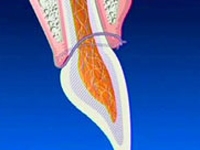
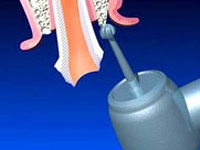
Crown Lengthening
A crown is an excellent way to cover and protect a tooth that has fractured or been damaged by decay or injury. Sometimes, however, the damage is so extensive that there simply isn’t enough tooth structure to support a crown. In these cases, we can often use a minor surgical procedure called crown lengthening.
This procedure increases the amount of available tooth structure so that the tooth can support a crown, which is the best choice for covering and protecting the tooth.
The Procedure
The first step in this procedure is to thoroughly numb the entire area. Incisions are made in the gums around the tooth, and then the gums are gently pulled back. Next, the bone and gum tissue are reshaped to reveal just enough of the natural tooth to create a secure anchor for a crown. The gums are replaced, and a couple of stitches are placed to speed healing. In some cases, we may also build up the tooth using a post and buildup material. After a few weeks of healing, a crown is placed to cover and protect the damaged tooth. The crown restores your damaged tooth to normal health, appearance, and chewing function.
Crown lengthening is a predictable and effective way to save a tooth that might otherwise be lost.


Flap Surgery
Periodontal flap surgery, also called pocket reduction surgery, is necessary when your gums still have pockets and infection even after we’ve completed a scaling and root planing procedure. Having gum pockets makes it much more difficult to remove plaque and bacteria from your teeth and gums, so it’s important to reduce the pockets.
Why is flap surgery necessary?
Flap surgery removes plaque, which is the sticky film of food and bacteria that forms on your teeth, and tartar, which is hardened and mineralized plaque. The bacteria in plaque and tartar are the source of the infection. Flap surgery also reduces the size of the gum pockets and helps the gum tissue heal and reattach to the bone, making it easier for you to keep the area plaque-free.
If plaque, bacteria, and infection are not removed, the infection will result the loss of the bone and connective fibers that hold your teeth firmly in place.
To begin the procedure, we first make sure all the areas are completely numb. Then we gently separate the gums from the tooth. This creates a flap and gives us access to the infected areas. Next, we remove any plaque and tartar from the root surfaces, smooth irregular surfaces on the bone, and reshape the gumline. When the procedure is complete, we’ll gently close the flap.
Any soreness after surgery can usually be handled well by mild pain medication. The results As the gum tissue heals, it tightens more closely around the tooth, and pockets are eliminated. This makes it easier for you to keep your teeth plaque-free. Periodontal flap surgery is an effective method for treating deep-seated periodontal disease and raising your overall level of health.
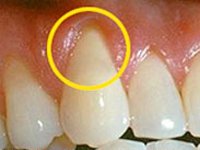


Gingival Grafting
Gingival grafting, also called soft tissue grafting, allows us to correct gums that have pulled away from the tooth and exposed the root surface. The gums may have receded because of periodontal disease or improper brushing techniques. Once the cause has been identified and controlled, gingival grafting can repair the loss of gum tissue and restore a healthy-looking smile.
Why is gingival grafting necessary?
When gums don’t completely cover the root surfaces, the apparent lengthening of the teeth can age a person’s smile. If left uncorrected, the loss of protective gum tissue can also make the tooth root more susceptible to decay and painful sensitivity. With grafting, we can return the gums to a more healthy and attractive state, with gums snug against the teeth and the roots covered.
The Procedure
The first step in placing a graft is to thoroughly numb the involved areas. Then the graft is taken from the donor site on the palate. In some cases, the incision heals on its own. In other cases, it’s closed with a stitch or two.
At the site of the graft, we gently separate the gums from the tooth. This creates a flap and gives us access to the area. Next, we remove any plaque and tartar from the root surfaces, and then the graft is carefully positioned and stitched in place.
The results
After healing for a few weeks, the grafted tissue blends in beautifully. Gingival grafting restores and strengthens the gums, covers and protects the root surfaces, and gives the tooth a much more natural and pleasing appearance.
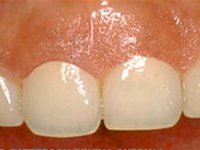

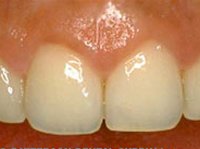
Gingivectomy
Gingivectomy, sometimes called gum reduction surgery, is a safe and predictable procedure for removing excess gum tissue from the front surface of the teeth.
Why is gingivectomy necessary?
When gums extend too far onto the front surface of the teeth, the natural balance between the length of the teeth and the height of the gums is lost. This can make the teeth appear too short. With a gingivectomy, we can return your gums to a more healthy and attractive condition.
A gingivectomy might also be necessary to remove diseased tissue.
The procedure
The first step in a gum reduction procedure is making sure that all of the involved areas are completely numb. We then carefully make a small incision and remove the excess gum tissue.
The results
After a couple of weeks, the area will be completely healed, and it will look much more natural, with the gums tight against the necks of the teeth. A gingivectomy is an effective method for improving the natural appearance of a person’s smile.


